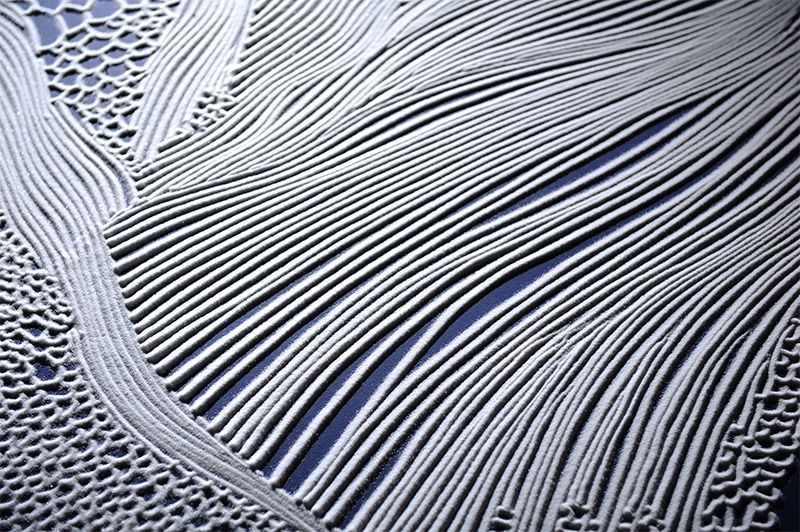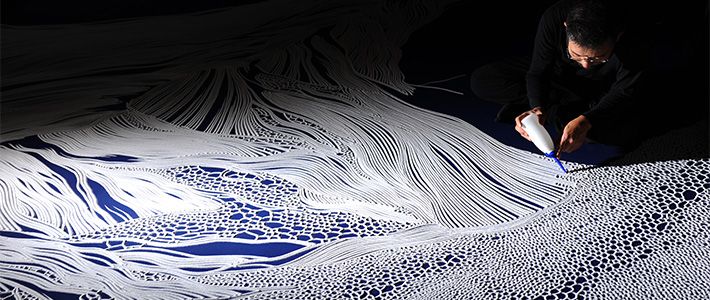
“Cool Traditions” Stay in Tune with Modern Life
A Requiem in Salt: Japanese Artist Yamamoto Motoi
Culture- English
- 日本語
- 简体字
- 繁體字
- Français
- Español
- العربية
- Русский
In Loving Memory
Yamamoto Motoi slowly walks up a gentle slope, his arms folded tightly as he gazes at a blue patch in the gray skies above the small island of Momoshima off the coast of Onomichi, Hiroshima Prefecture, in the Seto Inland Sea. The 51-year old artist is back in his hometown for a new piece, a sprawling installation made entirely of salt titled Ruri no Ryū (Lapis Dragon). After six days of nearly nonstop toil, he now looks over his artistic output with a sense of accomplishment and emancipation.
His creation, part of local gallery Art Base Momoshima’s exhibit Crossroad 2, represents both a return to work and a new direction for Yamamoto. It is his first artwork using a new technique and the first since his wife Junko succumbed to cancer the previous fall at age 43. After nearly a year hiatus, he has created the stunning piece as a requiem to his spouse and mother of their four-year-old daughter.
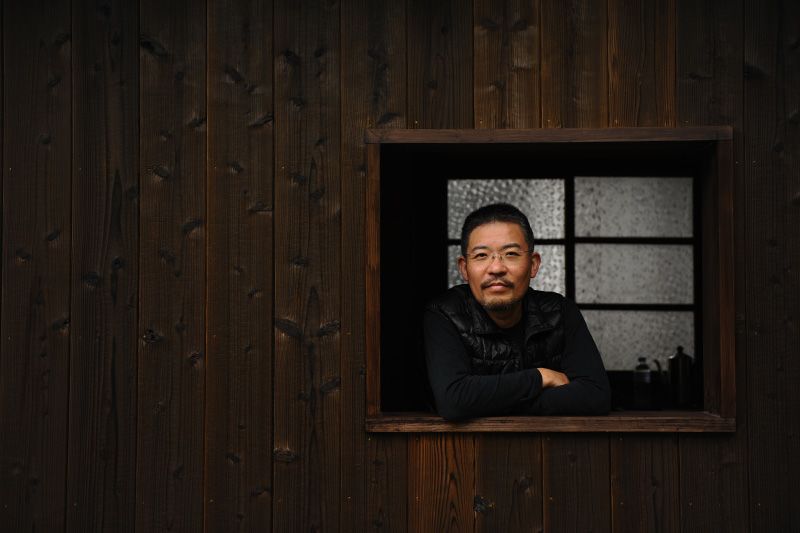 Yamamoto Motoi Born in 1966 in Onomichi, Hiroshima Prefecture. Graduated from Kanazawa College of Art in 1995. Currently resides in Kanazawa, Ishikawa Prefecture. Creates art installations using salt, which in Japan is considered to have purifying qualities. Has held exhibitions in Japan and abroad, including at the Hakone Open-Air Museum, the Setouchi Triennale, the State Hermitage Museum in St. Petersburg, Russia, and St. Peter’s Abbey in Salzburg, Austria.
Yamamoto Motoi Born in 1966 in Onomichi, Hiroshima Prefecture. Graduated from Kanazawa College of Art in 1995. Currently resides in Kanazawa, Ishikawa Prefecture. Creates art installations using salt, which in Japan is considered to have purifying qualities. Has held exhibitions in Japan and abroad, including at the Hakone Open-Air Museum, the Setouchi Triennale, the State Hermitage Museum in St. Petersburg, Russia, and St. Peter’s Abbey in Salzburg, Austria.
For Yamamoto, the blue sky has come to be a poignant reminder of his wife’s passing, and appears as a motif in his latest work. Staring up at the break in the clouds as he ambles along, the artist appears lost in memory as his eyes search the cobalt heavens.
Salt as Media
Yamamoto is unusual for his choice of medium. He does not dabble in paints or form sculptures from stone or metal but expresses his artistry with ordinary salt. He gives it shape with heat and water, and applies it directly using a special dispenser to create maze-like installations.
Salt is strongly associated with purification in Japanese culture. Yamamoto first used it for a piece he created following his younger sister Yūko’s death from a brain tumor in 1994. As he worked, the delicate crystals came to represent for him the fragility of life. As vulnerable to the whims of outside forces as humans, the translucent white lines epitomized his struggle to both accept the loss of his 24-year-old sister, whom he had cared for during her illness, and to memorialize her.
Since that time Yamamoto has worked almost exclusively in salt, using it to create works with basic themes that appeal to a broad spectrum of viewers. The result has been an iconic series of artwork for exhibits in Japan and abroad.
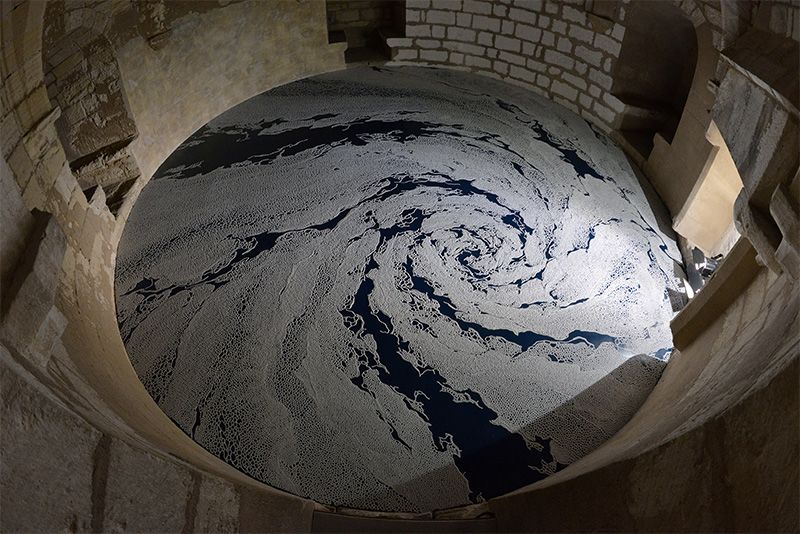 Yamamoto created his 2015 work Floating Garden inside the medieval French castle Aigues-Mortes. (© Yamamoto Motoi)
Yamamoto created his 2015 work Floating Garden inside the medieval French castle Aigues-Mortes. (© Yamamoto Motoi)
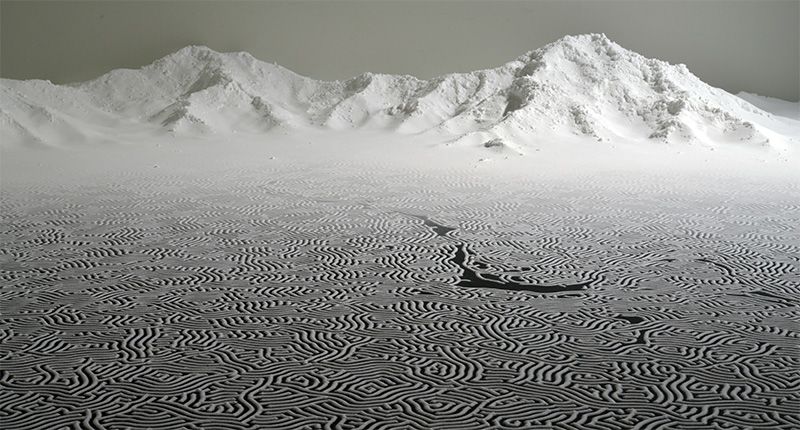 His 2013 work Labyrinth at the Hiroshima Prefectural Art museum. (© Yamamoto Motoi)
His 2013 work Labyrinth at the Hiroshima Prefectural Art museum. (© Yamamoto Motoi)
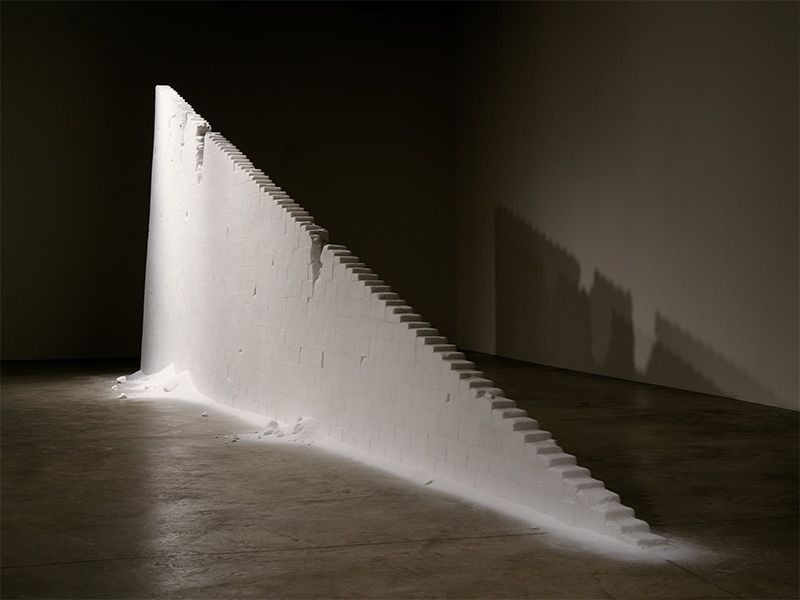 The 2003 salt staircase Utsusemi at the Museum of Modern Art, New York. (© Yamamoto Motoi)
The 2003 salt staircase Utsusemi at the Museum of Modern Art, New York. (© Yamamoto Motoi)
Connected to the Sea
When working on a piece Yamamoto spends seven or more hours sitting or kneeling, using the natural rhythm of his hands and body to guide his progress. He wryly admits to the harshness of these marathon session, and has developed an athlete-like ritual to tune his body for the days and even weeks needed to complete a creation. He begins each morning with stretches and strength training, then applies athletic tapes before gently massaging his limbs. If his warmup fails to silence his complaining muscles and joints, though, he will take an analgesic to dull the aches and pains.
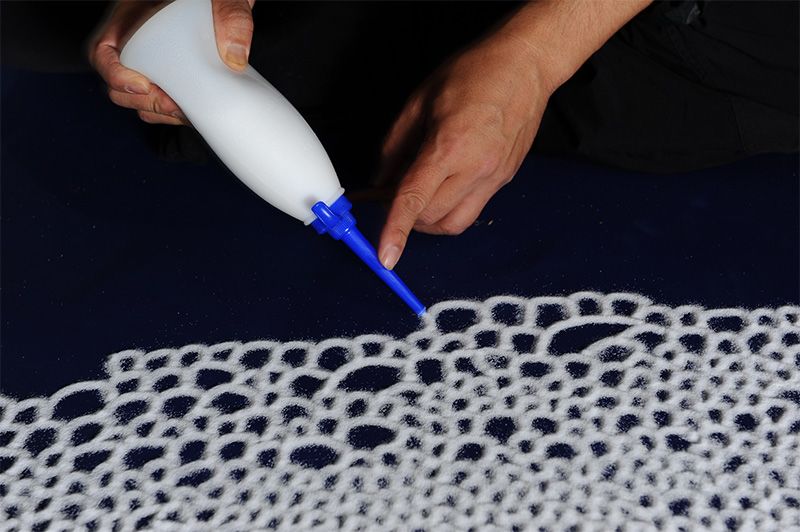 Yamamoto relies on the natural rhythm of his body to create his artworks.
Yamamoto relies on the natural rhythm of his body to create his artworks.
The routine helps him sustain his concentration, something that is essential when working with salt—an artistic medium that is extremely unstable and easily disturbed. While making it precarious to handle, these characteristics also make it a suitable material for Yamamoto’s transitory artworks. At the very least, Yamamoto hopes pieces will make it through a showing intact, though he admits with a chuckle that he needed to conduct repairs on several occasions following unexpected incidents.
In France there was an episode with a loose dog, and another occasion when an elderly woman with a cane mistakenly trod across a piece. In Germany the culprit was a museum curator who dropped a screwdriver. In Japan, too, the humid air of the Seto Inland Sea has proved to be an eroding force on finished artwork.
Yamamoto takes these events in stride and has learned to put the lessons they provide to good use. While working on Momoshima he surrounded the room housing his piece in sheets of clear plastic and ran a dehumidifier around the clock.
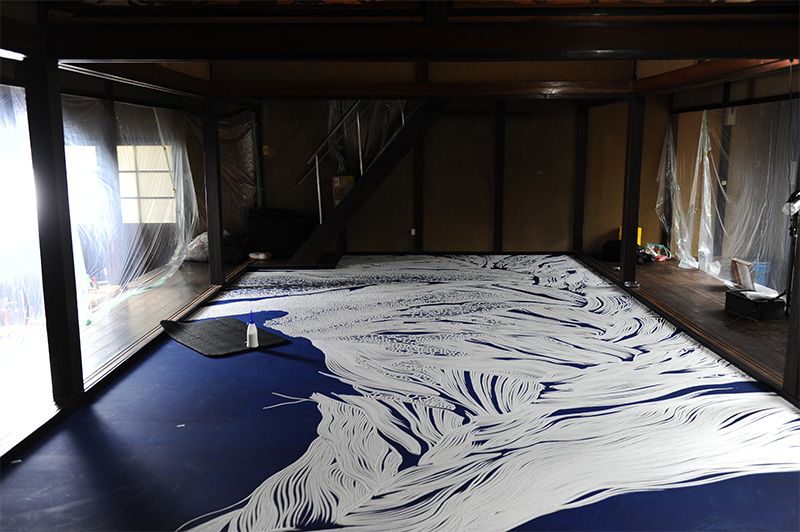 Yamamoto took special precautions while working on Ruri no Ryū.
Yamamoto took special precautions while working on Ruri no Ryū.
Works disappear quickly following an exhibit, so one of the first things Yamamoto does upon completing a piece is to photograph it in great detail. More than creating a record of his art, he says the photo lens provides a medium for blissfully intimate dialogue with his short-lived creations.
His installations are not simply discarded, though. Yamamoto drew attention in Japan and abroad in 2006 when at the end of an exhibit in North Carolina he requested the salt from his creation be collected and returned to the ocean. The idea gained momentum, and in 2007 a student at the Kyoto University of Art and Design christened the project “Returned to the Sea.” Since then visitors on the last day of an exhibit help collect the grains of salt from Yamamoto’s artwork, anywhere from a few kilograms to a several tons depending on the scale of a piece, and scatter them back into the sea.
A Voyage of Memories
Yamamoto’s five-year-old daughter Yūno sits near the artist as he pours his energy into the piece for the Momoshima exhibit. She attempts to quietly entertain herself, but overwhelmed by the tedium she invents different reasons to get her father’s attention. Yamamoto says with a smile that he does not mind the distractions. “I have learned over the past year how to remain focused despite the interruptions. And to be honest, I enjoy the little breaks.”
This is the first time Yamamoto has brought his daughter with him for an exhibit. Encouraged by the experience, he says he plans to take her with him to shows overseas to let her experience the world.
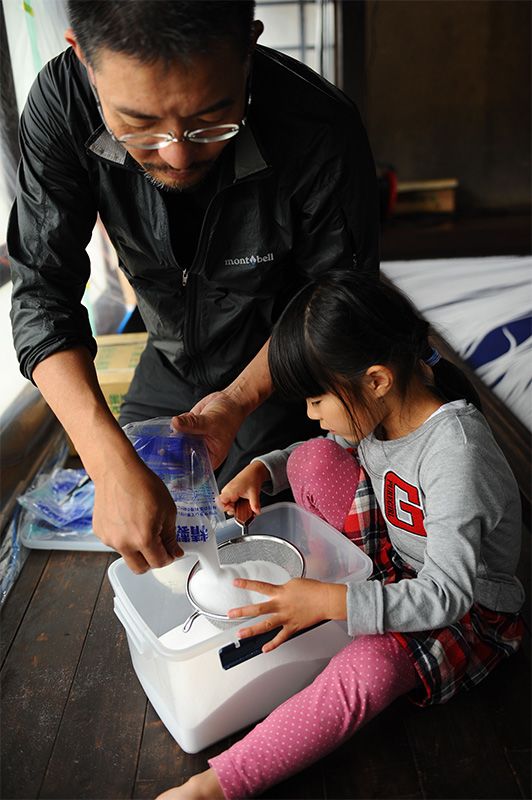 Yamamoto’s daughter Yūno helps prepare salt for an exhibit.
Yamamoto’s daughter Yūno helps prepare salt for an exhibit.
Yamamoto is experimenting with a new approach in creating Rurui no Ryū. Unlike his well-known labyrinths, the installation has a braided theme requiring long lines of salt, something he has never tried before. He is still undecided whether to combine the technique with other motifs or make it the center of a whole new series of works.
It is still too soon for such decisions, though. For now, Yamamoto continues to work through his grief in search of new artistic horizons.
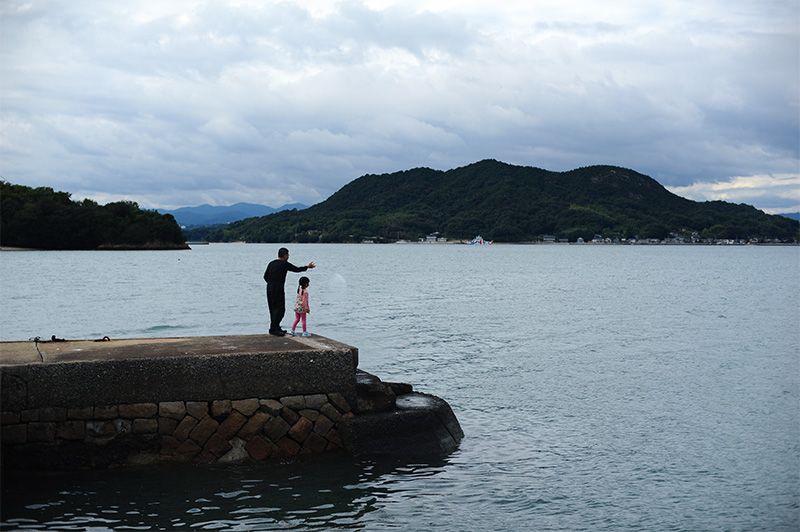 In Onomichi, Father and daughter return salt to the Seto Inland Sea.
In Onomichi, Father and daughter return salt to the Seto Inland Sea.
